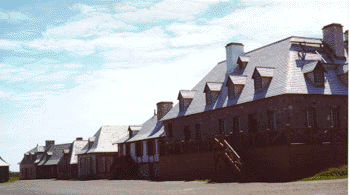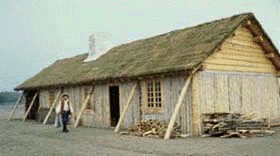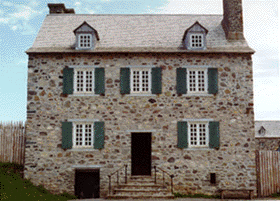Home:
 French:
 Glossary:
 Mail:
 |
Architecture
 There were two main categories of buildings constructed in eighteenth century Louisbourg. The first were constructed at royal expense and were often marked by an ornamental fleur-de-lis on the roof top. The others were built by private individuals. The buildings constructed at royal expense were certainly more elaborate and more costly the latter. Shelter from the elements was the prime concern for those who constructed private residences. Although, for those who could afford it, status, privacy and security were also considerations.
There were two main categories of buildings constructed in eighteenth century Louisbourg. The first were constructed at royal expense and were often marked by an ornamental fleur-de-lis on the roof top. The others were built by private individuals. The buildings constructed at royal expense were certainly more elaborate and more costly the latter. Shelter from the elements was the prime concern for those who constructed private residences. Although, for those who could afford it, status, privacy and security were also considerations.
 There were three styles of buildings in Louisbourg during the 1700s. The first and simplest was the piquet style. These buildings were constructed using upright posts, placed in a prepared trench or perhaps driven into the ground. The posts were then held together by braces. Cracks between them were caulked with moss, clay, earth or straw, often with a lime and sand roughcast mortar finish, known as crépi, as the final finish. The Des Roches House represents the piquet style.
There were three styles of buildings in Louisbourg during the 1700s. The first and simplest was the piquet style. These buildings were constructed using upright posts, placed in a prepared trench or perhaps driven into the ground. The posts were then held together by braces. Cracks between them were caulked with moss, clay, earth or straw, often with a lime and sand roughcast mortar finish, known as crépi, as the final finish. The Des Roches House represents the piquet style.
 The second style was called charpente (½ timber frame). These buildings were constructed with heavy framed walls of horizontal and vertical wooden beams, united by mortise and tenon joinery and wooden peg connections. The frame for these houses was usually erected on a foundation. Space between the timbers was filled with piquet posts or rubblestone. The Rodrigue House represents the charpente style.
The second style was called charpente (½ timber frame). These buildings were constructed with heavy framed walls of horizontal and vertical wooden beams, united by mortise and tenon joinery and wooden peg connections. The frame for these houses was usually erected on a foundation. Space between the timbers was filled with piquet posts or rubblestone. The Rodrigue House represents the charpente style.
 The third style of home was masonry. These homes were made completely of rubblestone with a foundation. Because of cost, few private buildings were built of stone. However, government officials preferred to build masonry structures. The average wall thickness was two feet at the base, which tapered towards the top. The Des Touches Residence represents the masonry style.
The third style of home was masonry. These homes were made completely of rubblestone with a foundation. Because of cost, few private buildings were built of stone. However, government officials preferred to build masonry structures. The average wall thickness was two feet at the base, which tapered towards the top. The Des Touches Residence represents the masonry style.
|

 There were two main categories of buildings constructed in eighteenth century Louisbourg. The first were constructed at royal expense and were often marked by an ornamental fleur-de-lis on the roof top. The others were built by private individuals. The buildings constructed at royal expense were certainly more elaborate and more costly the latter. Shelter from the elements was the prime concern for those who constructed private residences. Although, for those who could afford it, status, privacy and security were also considerations.
There were two main categories of buildings constructed in eighteenth century Louisbourg. The first were constructed at royal expense and were often marked by an ornamental fleur-de-lis on the roof top. The others were built by private individuals. The buildings constructed at royal expense were certainly more elaborate and more costly the latter. Shelter from the elements was the prime concern for those who constructed private residences. Although, for those who could afford it, status, privacy and security were also considerations.
 There were three styles of buildings in Louisbourg during the 1700s. The first and simplest was the piquet style. These buildings were constructed using upright posts, placed in a prepared trench or perhaps driven into the ground. The posts were then held together by braces. Cracks between them were caulked with moss, clay, earth or straw, often with a lime and sand roughcast mortar finish, known as crépi, as the final finish. The Des Roches House represents the piquet style.
There were three styles of buildings in Louisbourg during the 1700s. The first and simplest was the piquet style. These buildings were constructed using upright posts, placed in a prepared trench or perhaps driven into the ground. The posts were then held together by braces. Cracks between them were caulked with moss, clay, earth or straw, often with a lime and sand roughcast mortar finish, known as crépi, as the final finish. The Des Roches House represents the piquet style.
 The second style was called charpente (½ timber frame). These buildings were constructed with heavy framed walls of horizontal and vertical wooden beams, united by mortise and tenon joinery and wooden peg connections. The frame for these houses was usually erected on a foundation. Space between the timbers was filled with piquet posts or rubblestone. The Rodrigue House represents the charpente style.
The second style was called charpente (½ timber frame). These buildings were constructed with heavy framed walls of horizontal and vertical wooden beams, united by mortise and tenon joinery and wooden peg connections. The frame for these houses was usually erected on a foundation. Space between the timbers was filled with piquet posts or rubblestone. The Rodrigue House represents the charpente style.
 The third style of home was masonry. These homes were made completely of rubblestone with a foundation. Because of cost, few private buildings were built of stone. However, government officials preferred to build masonry structures. The average wall thickness was two feet at the base, which tapered towards the top. The Des Touches Residence represents the masonry style.
The third style of home was masonry. These homes were made completely of rubblestone with a foundation. Because of cost, few private buildings were built of stone. However, government officials preferred to build masonry structures. The average wall thickness was two feet at the base, which tapered towards the top. The Des Touches Residence represents the masonry style.


